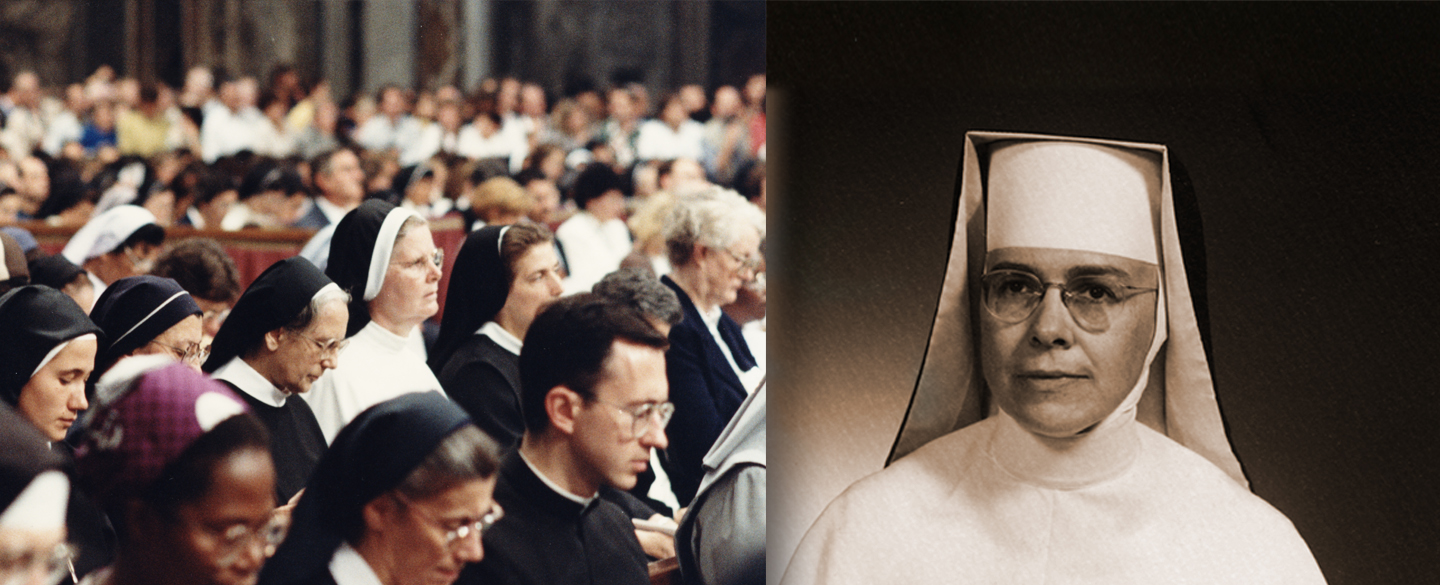
I beg you to intensify your prayer life. Do not shirk sacrifices and mortifications. The Congregation has thrived on them—she grew up and developed despite almost insurmountable obstacles. In hardship and want, it produced saints. In the tension of the Civil War, in heart-breaking financial calamities, in pestilence, and in endless days and nights of duty fatigue, the Congregation was faithful to prayer. Devotion to Our Lady stems from the very first night spent at St. Cecilia. In the eve of her conception, the sisters turned to Our Lady in the Rosary and placed this spot forever in her care. This community still produces saints, sisters—if we permit her. In fact, we live among them, and I am sure I have buried some. May it ever be so. (Mother Marie William MacGregor, January 18, 1969)

The Dominican Sisters of St. Cecilia have frequently been asked how, after the rapid changes following the Second Vatican Council, they managed to retain a sense of vitality and stability. Had not the community the benefit of dedicated and capable leadership at this time, undoubtedly St. Cecilia would not exist as it does today.
Mother Marie William MacGregor, O.P.
With an approach direct and insistent, Mother Marie William prepared the community for the renewal of religious life called for by the Council, and led the community through it. From the start of her term as Prioress General, her understanding of religious life and her vision for the community were clear. In her first Christmas letter to the community in 1964 she wrote a letter revealing her distinctive strength of devotion and personal concern:
I have searched my heart this season to find words to express my deepest desires for you. …That you will rediscover the beauty of poverty. That you will come to a fuller understanding of the dignity of obedience. That you will know complete fulfillment of your virginity. That any bitterness or hardness or selfishness that steals your smile or halts your laughter, may melt away at Christ Mass, when Divinity comes to nestle in your humanity. That at this Eucharistic meeting you will come to a fuller realization of the beauty of your vocation. That you will be filled with a new sense of worth. That your ideals may again reach for the stars, and coming to rest on the Star of Stars, be filled with awe and wonderment at the great things God has wrought in you.
As the 1960s and 1970s progressed, it became evident that what was at stake for all religious in the process of renewal was not any one observance or practice, but the religious life itself. The response given to Vatican Council II by religious institutes varied. After much real suffering, the response given by St. Cecilia Congregation was unequivocal.
With the publication of the conciliar decree Perfectae Caritatis, the history of religious institutes entered a new era. Their manner of life, prayer, work, and government was to be re-examined in the light of the goals of the apostolate and in accordance with the nature of the institute, as well as of cultural, social, and economic circumstances. In the St. Cecilia Congregation, committees were formed, studies were conducted and the Constitutions were revised in several stages.
During this period Mother Marie William’s strength and direction were clear. She seemed to know beforehand what would happen to many religious communities. She was a keen observer. She had a natural sense of the dramatic, the critical moment in a particular chain of events. She was sensitively responsive to what was being spoken and why. She took a stand on all issues of major importance. One such issue was contemplative life. “I am daily more and more convinced,” she wrote in 1968, “that if the contemplative attitude and atmosphere goes, so goes religious life.” In one of her letters to the community she states with conviction:
Our vocation calls for a deep love for Christ. Unless we achieve this, unless we suffer to overcome the relentless demands of our nature, we will have so little to offer. The call to holiness is universal—for Religious the vows were self-imposed and over and above the Christian commitment. Sisters, let us help one another! ...Be faithful to the heritage of community devotion. Above all else, nurture a constant and stable reliance on the Presence of Christ in the Blessed Sacrament. Pray, not necessarily long, but with deep love and earnestness.
Mother Marie William was instrumental in the formulation of a new organization of religious women who were concerned to preserve traditional religious life. Named Consortium Perfectae Caritatis, it consisted of major superiors of communities committed to a true spiritual renewal while at the same time not neglecting the process of authentically updating. Frequent travel and numerous meetings with members of the Sacred Congregation for Religious strengthened the group and supported their leadership in a time of great turbulence in the Church. It was here that Mother Marie William placed the Congregation in the heart of the Church. Following a meeting in Rome with the Secretary of the Congregation for Religious, Archbishop Augustine Mayer wrote to Mother Marie William:
Mother, I assure you again, as I have in the past, that our Sacred Congregation is pleased and consoled by the attitude and the courage of so many religious in the United States like your own, and that we do support you in your endeavor to be faithful to the ideals of the Religious Life, loyal to the Holy See, respectful of legitimate authority, concerned about the needs of the Church for works that still require your corporate commitment. I know it is not easy to resist the temptations in trying days like these but with God’s help you can continue to be the leader you have always shown yourself to be, encouraging and inspiring your own sisters and others that look to you for support.
Within the Congregation, the renewal process was punctuated by an emphasis on education that stressed intelligent fidelity. The documents of Vatican II were disseminated and studied and the sisters were directed to look to the Church for the direction and guidance the times demanded. The person and office of the Holy Father was to be respected and the sisters were told by their Prioress General, “listen to him, read and study carefully what he wants so that we may respond as loyal daughters of the Church and of St. Dominic.”
Along with strong admonitions to preserve the contemplative spirit, Mother Marie William was also a strong advocate of the religious habit and often made reference to it in her letters to the community. In a letter written in January of 1968 she expressed her conviction:
Let us remember that the habit is a symbol of our life-long dedication. In a crisis of self-identity, it gives you an identity. It is up to us to make it an effective sign, a sign worthy of the One it signifies. Wearing it presupposes a tremendous obligation on our part to be genuine witnesses. The habit will enhance this, not detract from it, if it is worn worthily.
As we reflect on the years that have followed in the Congregation and in the Church herself, we are clearly experiencing a springtime that is the fruit of the years of transition. Mother Marie William has left us a legacy, as she received from those who preceded her. With gratitude, we continue in the spirit of St. Dominic to live the charism with which we have been entrusted.
(The above is an adaptation of the chapter, Renewal after Vatican Council II, in The Nashville Dominicans: A History of the Congregation written by Sister Rose Marie Masserano, O.P.)
Promoting Religious Life
The years between 1976 and 1988 were filled with apostolic activity, the promotion of religious life nationally and internationally and work leading up to the approval of the Congregation’s Constitutions. Following the leadership of Mother Marie William, her successor, Mother Assumpta Long, traveled extensively for the cause of religious life. She frequently spoke to national assemblies of laity and churchmen to explain in clear terms the teaching of the Church in regard to religious life, as well as topics of interest such as the role of women today and authority in the Church. Contacts were made with members of the Curia and the Church’s hierarchy. Throughout these years the concerns of the universal Church continued to be at the center of the Congregation’s prayer life and concern.
School Expansion
During this time period, the following schools were assumed by the Congregation:
- 1965: Bishop Byrne High School and St. Paul School in Memphis, Tennessee
- 1971: Mount St. Catherine Primary School in Signal Mountain, Tennessee
- 1977: Aquinas School in Woodbridge, Virginia; St. Rose of Lima School in Cleveland, Ohio; Providence High School in New Lenox, Illinois
- 1985: Mount de Sales Academy in Baltimore, Maryland
Participation in the Synod on Religious
In 1988 the St. Cecilia Dominicans were blessed with the leadership of Mother Christine Born, whose gentle spirit and love for the universal Church provided the impetus to bring the Congregation into the next millennium.
Through her work as an officer in the Council of Major Superiors of Women Religious (founded in 1992), Mother Christine was invited by Pope John Paul II to participate as a working expert in the 1994 Synod on Religious held in Rome. For a period of four weeks, Mother Christine tracked the identity and nature of religious life, one of the Synod’s points of focus. Working in the heart of the Church, she brought her lived experience of consecrated life to the Synod floor.
As a member of the Synod, Mother Christine had the opportunity to have dinner one evening with the Holy Father. During the course of the meal one of the religious sisters present asked the Pope what his goal was for these lengthy proceedings. With his characteristic ability to penetrate to the heart of the matter, the Holy Father replied simply, “holiness.” At the meal’s end, Mother Christine thanked the Pontiff for all he had done for religious and religious life. The Pope replied, “It is Christ, it is Christ.” To that, Mother Christine said what every Dominican would consider to be an “ultimate” statement. She looked him in the eye and said, “Yes, Holy Father, it is Christ. But as our sister, St. Catherine has said, ‘You are sweet Christ on earth.’” To that the Pope nodded.


 Back
Back